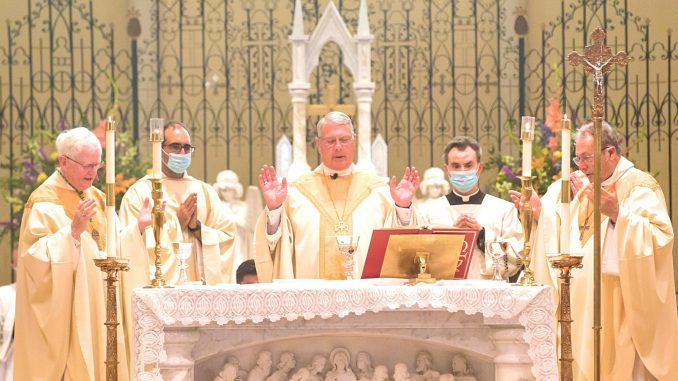
COLUMBIA—Two hundred years of faith, sacrifice and spreading the Gospel in the Diocese of Charleston were celebrated July 11 at a special Bicentennial Mass held at the Basilica of St. Peter in downtown Columbia.
The celebrant was Archbishop Gregory J. Hartmayer of the Archdiocese of Atlanta. Concelebrants were Bishop Robert E. Guglielmone and the Most. Rev. Kevin Boland, bishop emeritus of Savannah.
The liturgy marked the day 200 years ago (July 11, 1820) when the diocese was canonically erected by Pope Pius VII to include all of Georgia, North Carolina and South Carolina.
The Mass came at the end of a full day of events that started with Mayor John Tecklenburg of Charleston issuing a proclamation declaring July 11 “Roman Catholic Diocese of Charleston Day” in the city, followed by Bishop Guglielmone leading a rosary at historic St. Mary of the Annunciation Church on Hasell Street in downtown Charleston. The church, founded in 1789, was the first established site for Catholic worship in the Carolinas and Georgia.
The historic day concluded a year of celebrations that started on July 11, 2019, when Bishop Guglielmone led a Solemn Sung Vespers at the Cathedral of St. John the Baptist in Charleston. Many of the programs planned for this year had to be curtailed or scaled back due to the COVID-19 pandemic, but the commemorations continued.
The Mass drew more than a dozen priests and deacons from the diocese, as well as women religious, public officials and laypeople who turned out to mark the milestone. Hundreds of others watched the Mass from their homes via livestreaming.

Bishop Guglielmone told the congregation that the challenges the diocese has faced in 2020 are not unusual in its long history.
“If we look at the past 200 years, it has never been an easy road and the difficulties the Church has faced here have been many,” he said.
“Whoever thought in 2020 we would be wearing masks and trying to stay away from each other as we celebrate God’s love and our Bicentennial? Still, we pray the road ahead will be as fruitful and effective as the first 200 years have been.”
Bishop Boland was the homilist, and he focused on the life and work of Bishop John England, Charleston’s first bishop who served from 1820 until 1842.
Bishop Boland, also a native of County Cork, Ireland, described the daunting task Bishop England faced when he first arrived in South Carolina. At that time, he said, only five priests were available to serve the entire diocese, which encompassed more than 145,000 square miles in three states. Bishop England spent 39 of his first 55 days in the country traveling the expanse from Savannah and Augusta in Georgia to Columbia in the Midlands of South Carolina, then to North Carolina where he dedicated the first permanent Catholic church in that state. Trips that take only a few hours today took days back then, and the bishop had to travel by boat and stagecoach.
Those first journeys were the beginning of Bishop England’s 22 groundbreaking years and also showed his determination to be present for the faithful and to show pastoral outreach, Bishop Boland said.
He reflected on the fact that the entire structure of the Church in the Carolinas and Georgia — the Dioceses of Savannah, Charlotte and Raleigh, and the Archdiocese of Atlanta — all sprung from the foundation started by their first bishop.
“The name of Bishop England and his legacy that started here in South Carolina will endure,” Bishop Boland said. “His 22 years of service gave rise to the vibrancy of the faith in this state that still exists today.”
The Mass drew Lt. Governor Pamela Evette and Bryan Stirling, director of the South Carolina Department of Corrections, both Catholics. They said it offered an important chance to think about the role that the Church has played in the history of South Carolina.
“I’m proud to be able to reflect on the Bicentennial and also to stand with others in faith,” Lt. Governor Evette said. “When times are hard like they are now, our faith will get us through. It has always inspired me over the years and it is inspiring to hear about how it has carried on in the history of this diocese.”

